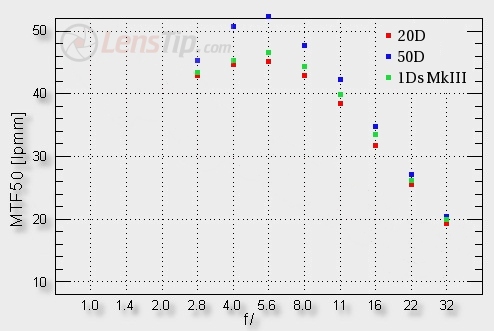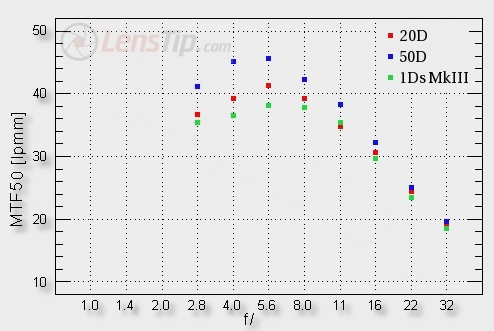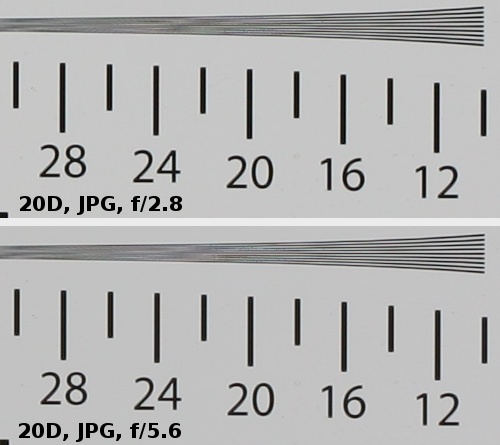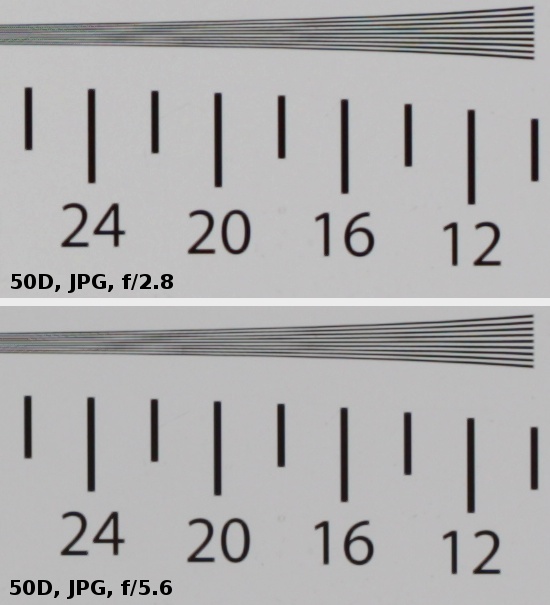Canon EF 100 mm f/2.8 L Macro IS USM
4. Image resolution
However there are two reasons which can persuade me to test optical devices on something more densely pixel-packed. First and perhaps the most serious one is autofocus. The EOS 20D is equipped with the oldest and the worst autofocus system of all the cameras we use currently in our optics tests. Most of our Readers have newer models with a better AF module, or they are planning to change the older ones so they are definitely more interested how a tested lens’s autofocus performs on a 50D, not on an old 20D. The second issue is the age of our 20D camera. Almost four years of strenuous work, 100 000 expositions, three maintenance calls. Although it still doesn’t distort the results because of its age it might stop working in the near future so anyway we’ll be facing a choice what to do: invest more money in it or buy something different instead.
To sum up: if the 20D had the autofocus from 40D/50D cameras, nobody would manage to talk me into changing it as such a move would bring only losses. Now I can compare the results between the 20D and the 1Ds MkIII with ease and, in the same time, obtain a very homogeneous tests sample, based on sensors with the same pixel density.
Please Support UsIf you enjoy our reviews and articles, and you want us to continue our work please, support our website by donating through PayPal. The funds are going to be used for paying our editorial team, renting servers, and equipping our testing studio; only that way we will be able to continue providing you interesting content for free. |
- - - - - - - - - - - - - - - - - - - - - - - - - - - - - - - - - - - - - - - - - - - - - - - -
As I have no option and tests on 20D can’t last forever, the Canon EF 100 mm f/2.8L IS USM Macro test was based on RAW files from as many as three bodies: the EOS 20D, the 50D and the 1Ds MkIII ( there were four bodies in fact, as we checked the RAW and mRAW files results from an EOS 7D as well, but we won’t mention it here). It will allow to assess differences arising from the usage of different detectors and it will give us an opportunity to compare the results as the tests overlap each other, when the 20D is mothballed for good. Let’s look at the situation for the frame centre.

So far, the record result on a 20D reached 46.0 ±0.5 lpmm and was achieved by another macro lens – a Canon EF-S 60 mm f/2.8. Here in fact the results aren’t worse. The maximum result, reached by the 100L amounts to 45.2 ±0.6 lpmm. Both values are, within the margin of error, similarly outstanding!
The word „outstanding” or „sensational” will appear quite often in this test because the results of the Canon 100L are exactly like that. At the maximum aperture we have almost 43 lpmm – even better than in the case of a much-praised EF-S 60 mm f/2.8, which brushed the level of 40 lpmm. What’s more, in the whole aperture range the 100L results are by several small lpmm better than an those of an ordinary 100 Canon macro lens, which, at the maximum aperture, reached 38.5 lpmm and its best result was “only” about 41 lpmm.
It’s already a tradition that the results obtained on the 1Ds MkIII imitate almost perfectly the 20D performance. The same pixels density causes such an effect. As the 1Ds MkIII sensor belongs to a professional model and is made using a newer technology, it allows to reach a tad better values so the results from the 1Ds MkIII tend to be a bit higher than those on the 20D. Here the advantage is slight, a bit lower than 2–3 lpmm we usually get, so it is difficult to say why – it might be caused by either outstanding possibilities of the tested L lens or small systematic errors, not always possible to avoid.
Let’s pass to the description of results from the EOS 50D. There’s one serious argument why you should exchange a testing body for the very 50D camera, if you have to exchange it at all, not for a 40D or a 7D. The maximum result the 100L can obtain on the 50D matrix is just a bit above 52 lpmm. It is worth reminding that maximum results of the 51 lpmm level have also 4/3 system lenses, tested by us on an E-3. Exactly the same values are reached by M lenses, tested on a Leica M9. When we test on a 50D there’s plenty to compare with. Especially that if we ever exchange our Nikon D200 for a Nikon D300s, then its 12-megapixels sensor is also able to make the lenses reach the level of 51-52 lpmm.
The next argument for 50D tests, although not so important one, is the graph appearance. It is worth notice that the difference between the 20D and the 50D at the maximum aperture is smaller than by f/5.6. It is in accordance with our expectations. At the maximum aperture a nice MTF of densely packed sensor is quite effectively damped down by a worse MTF of a lens. In a point where the lens is at the peak of its abilities, both MTF values enhance each other’s results, reaching over 52 lpmm. It allows us to play with the numbers and to draw stronger conclusions because the differences between particular apertures are higher than the margin of measurement error. On the other hand, though, if all lenses, tested on the 20D, were tested once again on the 50D, the conclusions in the summary wouldn’t change at all.
As we have the 50D results perhaps it would be good if we compared them with the 4/3 system results, especially that the Olympus ZD 50 mm f/2.0 ED Macro test is available in our database. The Olympus by f/2.8 reaches a bit above 48 lpmm whereas the 100L – almost 46 lpmm. The Olympus is a bit better here but you should remember that its maximum aperture amounts to f/2.0 so we compare one lens working wide open with the other closed down by 1 EV. It doesn’t change the fact that both lenses perform brilliantly at the maximum aperture and on stopping down alike.
Let’s see what the situation looks like at the frame edge.

Let’s start with the 20D. Once again the words “outstanding” and “sensational” simply can’t wait to get out. At the maximum aperture we have a result of over 36 lpmm and by f/5.6 – about 41 lpmm, so as much as the older EF 100 f/2.8 reached in the centre!
The results from the 50D once again will allow us an easy comparison of the 100L with the ZD 50 mm Macro lens from Olympus. By f/2.8 the Olympus prevails again but by f/4.0-5.6 the results are very much the same. Here we must remember, though, that, apart from the aperture difference, we have to deal with the fact that the APS-C sensor border is further apart from the optical axis of the system than the edge of a smaller 4/3 sensor. The Olympus has it a bit easier here but it was, after all, the very idea of that system – a smaller sensor, less problems at the edge.
The full frame edge performance of the 100L was really the thing that made us go into raptures, though. Even wide open, the tested lens allows us to take very sharp photos because the measured MTF50 value amounts to almost 36 lpmm. In general, the performance at the full frame edge for the whole aperture range is just by several tiny lpmm worse than on the APS-C sensor. It is a result worth every praise.
To sum up the tested lens’s behaviour cannot be faulted here. It doesn’t matter whether we speak about the frame centre, the APS-C senor edge or the full frame border.
 |
 |






